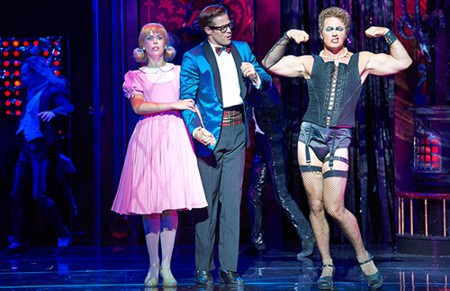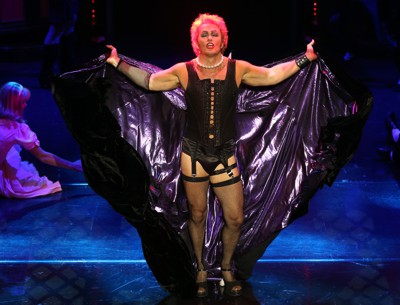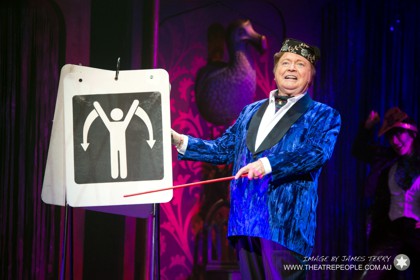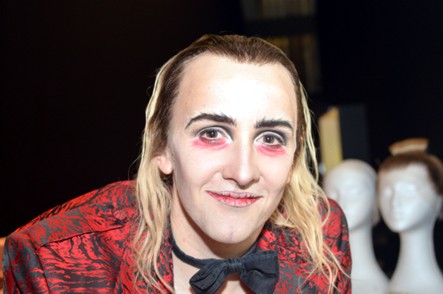THE ROCKY HORROR SHOW REVIEW (LYRIC THEATRE, SYDNEY)
Oh, Rocky! What have they done to you, you magnificent, sexy beast? When did you become so polite? So light? So completely inconsequential? When did you embrace the “party musical” label with such force that you almost completely abandoned your roots as, you know, a piece of theatre? When did one of the most influential, subversive and shocking pieces of queer culture become nothing more than another crowd-pleasing, mainstream musical blockbuster, and end up feeling like Mamma Mia?

This new 40th anniversary production of Richard O’Brien’s seminal cult rock’n'roll musical is basically the cartoon version of the iconic 1975 Tim Curry-led film. There are costumes by Sue Blane which turn the volume up on the film designs — for example, Janet’s pink dress is now a far brighter pink, and she has Carol Brady hair — and a small, versatile set by Hugh Durrant, framed by giant rolls of old film. (The set, which comes from a UK touring production, is far too small for the 2000-seat Lyric Theatre). Visually, at least, it’s all rather sanitised. Where’s the scrappiness? There’s a carefully torn show curtain, but not a ripped fishnet in sight.

The audience absolutely laps up Craig McLachlan as Dr Frank N Furter, and it’s a generous performance in that he gives the majority of folks exactly what they want. But, to my mind, it’s shallow, hammy and entirely lacking in any danger or intrigue. Frank should invite an audience to lean in and occasionally recoil, rather than reaching out to them in every scene. It’s also great to go off-script and respond to the rabble, but it shouldn’t go so far that it destroys your character’s dramatic arc. Frank should have motivations beyond trying to drag a laugh out of the audience with erection jokes. Frank is cheap and nasty, but there’s more lurking under the surface.
To McLachlan’s credit, by the time he reaches the Floor Show, he brings some integrity to his performance and doesn’t try to pull a joke out of “Whatever happened to Fay Wray? That delicate, satin-draped frame. As it clung to her thigh, how I started to cry, ’cause I wanted to be dressed just the same.” But by then, McLachlan has played all of Frank’s sexual exploits and experiments with gender purely for laughs, so it’s impossible to really care. His approach to gender and sexuality is playful, but it shouldn’t be the joke it has become here.
There are some very strong supporting performances, which build up a slightly more interesting world around McLachlan’s Frank. Amy Lehpamer has traced the journey of Janet from innocent virgin to liberated sex kitten with surprising dexterity and versatile, powerful vocals. Her Touch-a Touch-a Touch Me is one of few thrilling moments. Angelique Cassimatis and Jayde Westaby are both fireballs as Columbia and Magenta, respectively.
Kristian Lavercombe’s Riff Raff follows the template set by O’Brien a little too closely, but he belts the bejesus out of the score, while Stephen Mahy’s Brad is fine as the all-American jock, but could do with a little more grunt in some moments.
And if producer John Frost must continue to shoehorn Bert Newton into musicals, his role as narrator is a perfect fit. Newton also had the best comeback on opening night to a heckler who suggested his career was over. Hats off, Bert.

Australia has a strong history with Rocky Horror. The original 1973 London production (in the 63-seat upstairs space at the Royal Court Theatre) was directed and designed by Australians Jim Sharman and Brian Thomson. The Australian production, which opened less than a year later, became legendary. It’s one of the defining moments of Reg Livermore’s career, and people still talk about his Frank. I can’t vouch for his performance in the role, as I wasn’t even alive back then, but the original Australian cast recording is absolute dynamite — raw, rocking and irresistible (seriously, find it on iTunes or Spotify and have a listen).
It’s a shame that the most recent Rocky down under – Gale Edwards’ genuinely fresh take on the show in 2008 — has been followed up with something quite so stale. Edwards’ production was intellectually rigorous, sexy, and yet still managed to give the audience what they wanted as a “party musical”. And it had iOta as a Frank who, while borrowing heavily from Tim Curry, had charisma, power and a respect for the source material.
And that’s what seems so curiously lacking from this production which goes to every effort to reproduce the look and sound (although the sound design is rather tinny) of the film multitudes of fans have come to know and love. Director Christopher Luscombe has fundamentally mishandled the book so that it meanders from cheap gag to cheap gag and song to song.
Despite what your strongest memories of Rocky are, it works because it has an excellent, subversive and witty book about sexual liberation and coming of age. But you wouldn’t necessarily realise that from this production, in which dramatic beats are constantly missed. There’s a brilliantly dangerous moment when Frank hands Brad and Janet two white lab coats after they’ve just been stripped down to their underwear. He says: “Put these on. They’ll make you feel less … vulnerable.” Frank carefully chooses his final word to gently manipulate Brad and Janet. In this production, it’s simply: “Put these on. They’ll make you feel less vulnerable.”
Rocky Horror desperately needs a director who will go back to the words on the page, unpack exactly what they mean — and what they mean today – and take their time considering how they want to tell that story. I believe Rocky Horror is one of the legitimately great musicals of the latter half of the 20th century. It should be a hell of a lot of fun, but it has to be something more. It’s not a shallow piece of fluff, and if your audience leaves with no higher praise than “that was a fun night out”, you’re not doing it right.



